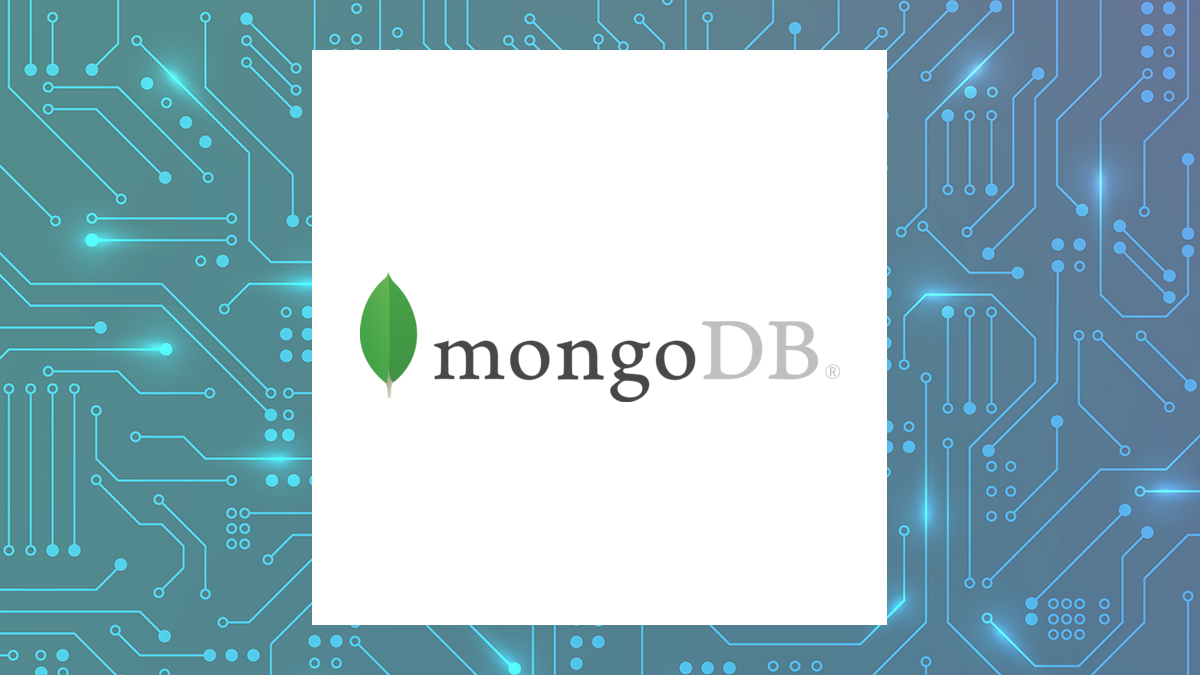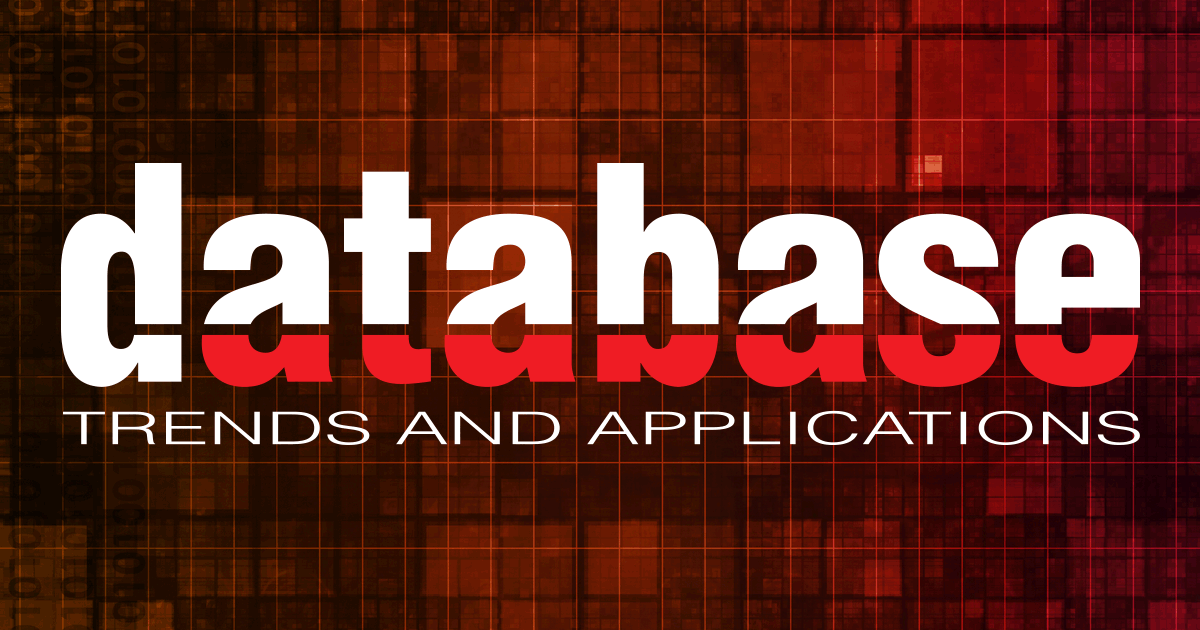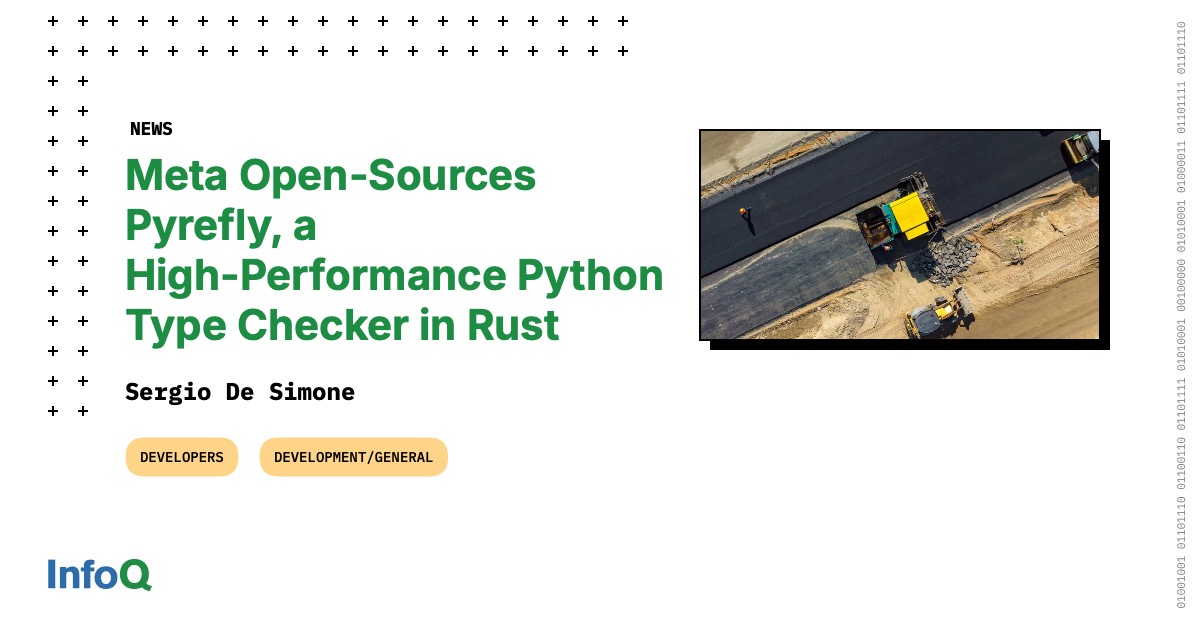Month: May 2025

MMS • RSS
 MongoDB, Inc. (NASDAQ:MDB – Get Free Report) saw unusually large options trading activity on Wednesday. Traders bought 23,831 put options on the stock. This is an increase of 2,157% compared to the average daily volume of 1,056 put options.
MongoDB, Inc. (NASDAQ:MDB – Get Free Report) saw unusually large options trading activity on Wednesday. Traders bought 23,831 put options on the stock. This is an increase of 2,157% compared to the average daily volume of 1,056 put options.
MongoDB Price Performance
Shares of NASDAQ:MDB opened at $188.45 on Thursday. The company’s fifty day moving average price is $174.52 and its 200-day moving average price is $234.21. The firm has a market capitalization of $15.30 billion, a price-to-earnings ratio of -68.78 and a beta of 1.49. MongoDB has a one year low of $140.78 and a one year high of $370.00.
MongoDB (NASDAQ:MDB – Get Free Report) last issued its quarterly earnings results on Wednesday, March 5th. The company reported $0.19 EPS for the quarter, missing analysts’ consensus estimates of $0.64 by ($0.45). The company had revenue of $548.40 million during the quarter, compared to the consensus estimate of $519.65 million. MongoDB had a negative return on equity of 12.22% and a negative net margin of 10.46%. During the same period in the previous year, the company earned $0.86 EPS. As a group, equities research analysts expect that MongoDB will post -1.78 EPS for the current year.
Wall Street Analyst Weigh In
A number of research analysts have recently weighed in on the stock. KeyCorp downgraded shares of MongoDB from a “strong-buy” rating to a “hold” rating in a research report on Wednesday, March 5th. Barclays reduced their target price on shares of MongoDB from $280.00 to $252.00 and set an “overweight” rating for the company in a research report on Friday, May 16th. UBS Group set a $350.00 target price on shares of MongoDB in a research report on Tuesday, March 4th. Oppenheimer reduced their target price on shares of MongoDB from $400.00 to $330.00 and set an “outperform” rating for the company in a research report on Thursday, March 6th. Finally, Citigroup reduced their target price on shares of MongoDB from $430.00 to $330.00 and set a “buy” rating for the company in a research report on Tuesday, April 1st. Nine analysts have rated the stock with a hold rating, twenty-three have given a buy rating and one has given a strong buy rating to the company. Based on data from MarketBeat, MongoDB presently has a consensus rating of “Moderate Buy” and an average price target of $286.88.
Check Out Our Latest Stock Report on MDB
Insider Transactions at MongoDB
In other MongoDB news, CFO Srdjan Tanjga sold 525 shares of the company’s stock in a transaction dated Wednesday, April 2nd. The shares were sold at an average price of $173.26, for a total value of $90,961.50. Following the completion of the sale, the chief financial officer now directly owns 6,406 shares of the company’s stock, valued at approximately $1,109,903.56. This represents a 7.57% decrease in their position. The sale was disclosed in a document filed with the SEC, which is accessible through the SEC website. Also, Director Dwight A. Merriman sold 3,000 shares of the company’s stock in a transaction dated Monday, March 3rd. The stock was sold at an average price of $270.63, for a total transaction of $811,890.00. Following the completion of the sale, the director now directly owns 1,109,006 shares of the company’s stock, valued at $300,130,293.78. The trade was a 0.27% decrease in their ownership of the stock. The disclosure for this sale can be found here. Insiders sold a total of 25,203 shares of company stock valued at $4,660,459 over the last three months. Corporate insiders own 3.60% of the company’s stock.
Hedge Funds Weigh In On MongoDB
Institutional investors have recently made changes to their positions in the stock. Strategic Investment Solutions Inc. IL bought a new position in shares of MongoDB in the 4th quarter worth $29,000. Cloud Capital Management LLC bought a new position in shares of MongoDB during the 1st quarter valued at $25,000. NCP Inc. bought a new position in shares of MongoDB during the 4th quarter valued at $35,000. Hollencrest Capital Management bought a new position in shares of MongoDB during the 1st quarter valued at $26,000. Finally, Cullen Frost Bankers Inc. grew its holdings in shares of MongoDB by 315.8% during the 1st quarter. Cullen Frost Bankers Inc. now owns 158 shares of the company’s stock valued at $28,000 after purchasing an additional 120 shares during the last quarter. Institutional investors own 89.29% of the company’s stock.
MongoDB Company Profile
MongoDB, Inc, together with its subsidiaries, provides general purpose database platform worldwide. The company provides MongoDB Atlas, a hosted multi-cloud database-as-a-service solution; MongoDB Enterprise Advanced, a commercial database server for enterprise customers to run in the cloud, on-premises, or in a hybrid environment; and Community Server, a free-to-download version of its database, which includes the functionality that developers need to get started with MongoDB.
Recommended Stories
Receive News & Ratings for MongoDB Daily – Enter your email address below to receive a concise daily summary of the latest news and analysts’ ratings for MongoDB and related companies with MarketBeat.com’s FREE daily email newsletter.

MMS • RSS
 MongoDB (NASDAQ:MDB – Free Report) had its target price reduced by Guggenheim from $300.00 to $235.00 in a report issued on Wednesday morning,Benzinga reports. They currently have a buy rating on the stock.
MongoDB (NASDAQ:MDB – Free Report) had its target price reduced by Guggenheim from $300.00 to $235.00 in a report issued on Wednesday morning,Benzinga reports. They currently have a buy rating on the stock.
Other analysts have also issued research reports about the company. Royal Bank of Canada reissued an “outperform” rating and issued a $320.00 target price on shares of MongoDB in a research report on Tuesday, May 20th. Piper Sandler cut their target price on MongoDB from $280.00 to $200.00 and set an “overweight” rating on the stock in a research report on Wednesday, April 23rd. Daiwa Capital Markets started coverage on MongoDB in a research report on Tuesday, April 1st. They issued an “outperform” rating and a $202.00 target price on the stock. Loop Capital lowered MongoDB from a “buy” rating to a “hold” rating and cut their target price for the company from $350.00 to $190.00 in a research report on Tuesday, May 20th. Finally, KeyCorp lowered MongoDB from a “strong-buy” rating to a “hold” rating in a research report on Wednesday, March 5th. Nine equities research analysts have rated the stock with a hold rating, twenty-three have given a buy rating and one has issued a strong buy rating to the company’s stock. According to MarketBeat, the company presently has an average rating of “Moderate Buy” and a consensus price target of $286.88.
Check Out Our Latest Analysis on MongoDB
MongoDB Stock Performance
MDB stock opened at $188.45 on Wednesday. The firm has a market cap of $15.30 billion, a PE ratio of -68.78 and a beta of 1.49. The firm’s 50 day moving average price is $174.52 and its 200-day moving average price is $234.21. MongoDB has a one year low of $140.78 and a one year high of $370.00.
MongoDB (NASDAQ:MDB – Get Free Report) last released its quarterly earnings results on Wednesday, March 5th. The company reported $0.19 EPS for the quarter, missing the consensus estimate of $0.64 by ($0.45). The firm had revenue of $548.40 million for the quarter, compared to analysts’ expectations of $519.65 million. MongoDB had a negative net margin of 10.46% and a negative return on equity of 12.22%. During the same period in the previous year, the firm posted $0.86 EPS. Equities research analysts predict that MongoDB will post -1.78 EPS for the current fiscal year.
Insider Activity at MongoDB
In other MongoDB news, Director Dwight A. Merriman sold 3,000 shares of the company’s stock in a transaction on Monday, March 3rd. The shares were sold at an average price of $270.63, for a total value of $811,890.00. Following the completion of the transaction, the director now owns 1,109,006 shares in the company, valued at $300,130,293.78. This represents a 0.27% decrease in their ownership of the stock. The transaction was disclosed in a legal filing with the SEC, which is available at this hyperlink. Also, CAO Thomas Bull sold 301 shares of the company’s stock in a transaction on Wednesday, April 2nd. The shares were sold at an average price of $173.25, for a total transaction of $52,148.25. Following the completion of the transaction, the chief accounting officer now owns 14,598 shares of the company’s stock, valued at $2,529,103.50. This represents a 2.02% decrease in their position. The disclosure for this sale can be found here. Insiders have sold 25,203 shares of company stock valued at $4,660,459 over the last quarter. 3.60% of the stock is owned by insiders.
Hedge Funds Weigh In On MongoDB
Several large investors have recently bought and sold shares of MDB. Blue Trust Inc. boosted its stake in MongoDB by 59.4% in the fourth quarter. Blue Trust Inc. now owns 1,478 shares of the company’s stock valued at $344,000 after acquiring an additional 551 shares in the last quarter. KBC Group NV boosted its stake in MongoDB by 5.2% in the fourth quarter. KBC Group NV now owns 18,079 shares of the company’s stock valued at $4,209,000 after acquiring an additional 890 shares in the last quarter. Pacer Advisors Inc. boosted its stake in MongoDB by 12.6% in the fourth quarter. Pacer Advisors Inc. now owns 5,504 shares of the company’s stock valued at $1,281,000 after acquiring an additional 615 shares in the last quarter. Perigon Wealth Management LLC boosted its stake in MongoDB by 2.7% in the fourth quarter. Perigon Wealth Management LLC now owns 2,528 shares of the company’s stock valued at $627,000 after acquiring an additional 66 shares in the last quarter. Finally, R Squared Ltd acquired a new stake in shares of MongoDB during the fourth quarter worth about $163,000. Institutional investors and hedge funds own 89.29% of the company’s stock.
About MongoDB
MongoDB, Inc, together with its subsidiaries, provides general purpose database platform worldwide. The company provides MongoDB Atlas, a hosted multi-cloud database-as-a-service solution; MongoDB Enterprise Advanced, a commercial database server for enterprise customers to run in the cloud, on-premises, or in a hybrid environment; and Community Server, a free-to-download version of its database, which includes the functionality that developers need to get started with MongoDB.
Read More
Receive News & Ratings for MongoDB Daily – Enter your email address below to receive a concise daily summary of the latest news and analysts’ ratings for MongoDB and related companies with MarketBeat.com’s FREE daily email newsletter.
Amazon DocumentDB (with MongoDB compatibility) Announces 99.99% Service Level Agreement

MMS • RSS

Amazon DocumentDB (with MongoDB compatibility) announces an updated Service Level Agreement (SLA), promising a 99.99% availability when using a Multi-Availability Zone (Multi-AZ) configuration. Previously, Amazon DocumentDB offered a 99.9% SLA. Now, Amazon DocumentDB has updated the SLA to 99.99%, increasing our commitment to service availability.
Amazon DocumentDB (with MongoDB compatibility) is a fully managed native JSON document database that makes it easy and cost effective to operate critical document workloads at virtually any scale without managing infrastructure. The updated SLA for Amazon DocumentDB applies to all regions where DocumentDB is generally available, at no additional cost. To learn more about Amazon DocumentDB, please see our product page and documentation.

MMS • RSS

Artificial intelligence is the greatest investment opportunity of our lifetime. The time to invest in groundbreaking AI is now, and this stock is a steal!
AI is eating the world—and the machines behind it are ravenous.
Each ChatGPT query, each model update, each robotic breakthrough consumes massive amounts of energy. In fact, AI is already pushing global power grids to the brink.
Wall Street is pouring hundreds of billions into artificial intelligence—training smarter chatbots, automating industries, and building the digital future. But there’s one urgent question few are asking:
Where will all of that energy come from?
AI is the most electricity-hungry technology ever invented. Each data center powering large language models like ChatGPT consumes as much energy as a small city. And it’s about to get worse.
Even Sam Altman, the founder of OpenAI, issued a stark warning:
“The future of AI depends on an energy breakthrough.”
Elon Musk was even more blunt:
“AI will run out of electricity by next year.”
As the world chases faster, smarter machines, a hidden crisis is emerging behind the scenes. Power grids are strained. Electricity prices are rising. Utilities are scrambling to expand capacity.
And that’s where the real opportunity lies…
One little-known company—almost entirely overlooked by most AI investors—could be the ultimate backdoor play. It’s not a chipmaker. It’s not a cloud platform. But it might be the most important AI stock in the US owns critical energy infrastructure assets positioned to feed the coming AI energy spike.
As demand from AI data centers explodes, this company is gearing up to profit from the most valuable commodity in the digital age: electricity.
The “Toll Booth” Operator of the AI Energy Boom
- It owns critical nuclear energy infrastructure assets, positioning it at the heart of America’s next-generation power strategy.
- It’s one of the only global companies capable of executing large-scale, complex EPC (engineering, procurement, and construction) projects across oil, gas, renewable fuels, and industrial infrastructure.
- It plays a pivotal role in U.S. LNG exportation—a sector about to explode under President Trump’s renewed “America First” energy doctrine.
Trump has made it clear: Europe and U.S. allies must buy American LNG.
And our company sits in the toll booth—collecting fees on every drop exported.
But that’s not all…
As Trump’s proposed tariffs push American manufacturers to bring their operations back home, this company will be first in line to rebuild, retrofit, and reengineer those facilities.
AI. Energy. Tariffs. Onshoring. This One Company Ties It All Together.
While the world is distracted by flashy AI tickers, a few smart investors are quietly scooping up shares of the one company powering it all from behind the scenes.
AI needs energy. Energy needs infrastructure.
And infrastructure needs a builder with experience, scale, and execution.
This company has its finger in every pie—and Wall Street is just starting to notice.
Wall Street is noticing this company also because it is quietly riding all of these tailwinds—without the sky-high valuation.
While most energy and utility firms are buried under mountains of debt and coughing up hefty interest payments just to appease bondholders…
This company is completely debt-free.
In fact, it’s sitting on a war chest of cash—equal to nearly one-third of its entire market cap.
It also owns a huge equity stake in another red-hot AI play, giving investors indirect exposure to multiple AI growth engines without paying a premium.
And here’s what the smart money has started whispering…
The Hedge Fund Secret That’s Starting to Leak Out
This stock is so off-the-radar, so absurdly undervalued, that some of the most secretive hedge fund managers in the world have begun pitching it at closed-door investment summits.
They’re sharing it quietly, away from the cameras, to rooms full of ultra-wealthy clients.
Why? Because excluding cash and investments, this company is trading at less than 7 times earnings.
And that’s for a business tied to:
- The AI infrastructure supercycle
- The onshoring boom driven by Trump-era tariffs
- A surge in U.S. LNG exports
- And a unique footprint in nuclear energy—the future of clean, reliable power
You simply won’t find another AI and energy stock this cheap… with this much upside.
This isn’t a hype stock. It’s not riding on hope.
It’s delivering real cash flows, owns critical infrastructure, and holds stakes in other major growth stories.
This is your chance to get in before the rockets take off!
Disruption is the New Name of the Game: Let’s face it, complacency breeds stagnation.
AI is the ultimate disruptor, and it’s shaking the foundations of traditional industries.
The companies that embrace AI will thrive, while the dinosaurs clinging to outdated methods will be left in the dust.
As an investor, you want to be on the side of the winners, and AI is the winning ticket.
The Talent Pool is Overflowing: The world’s brightest minds are flocking to AI.
From computer scientists to mathematicians, the next generation of innovators is pouring its energy into this field.
This influx of talent guarantees a constant stream of groundbreaking ideas and rapid advancements.
By investing in AI, you’re essentially backing the future.
The future is powered by artificial intelligence, and the time to invest is NOW.
Don’t be a spectator in this technological revolution.
Dive into the AI gold rush and watch your portfolio soar alongside the brightest minds of our generation.
This isn’t just about making money – it’s about being part of the future.
So, buckle up and get ready for the ride of your investment life!
Act Now and Unlock a Potential 100+% Return within 12 to 24 months.
We’re now offering month-to-month subscriptions with no commitments.
For a ridiculously low price of just $9.99 per month, you can unlock our in-depth investment research and exclusive insights – that’s less than a single fast food meal!
Here’s why this is a deal you can’t afford to pass up:
- Access to our Detailed Report on our AI, Tariffs, and Nuclear Energy Stock with 100+% potential upside within 12 to 24 months
- BONUS REPORT on our #1 AI-Robotics Stock with 10000% upside potential: Our in-depth report dives deep into our #1 AI/robotics stock’s groundbreaking technology and massive growth potential.
- One New Issue of Our Premium Readership Newsletter: You will also receive one new issue per month and at least one new stock pick per month from our monthly newsletter’s portfolio over the next 12 months. These stocks are handpicked by our research director, Dr. Inan Dogan.
- One free upcoming issue of our 70+ page Quarterly Newsletter: A value of $149
- Bonus Content: Premium access to members-only fund manager video interviews
- Ad-Free Browsing: Enjoy a month of investment research free from distracting banner and pop-up ads, allowing you to focus on uncovering the next big opportunity.
- Lifetime Price Guarantee: Your renewal rate will always remain the same as long as your subscription is active.
- 30-Day Money-Back Guarantee: If you’re not absolutely satisfied with our service, we’ll provide a full refund within 30 days, no questions asked.
Space is Limited! Only 1000 spots are available for this exclusive offer. Don’t let this chance slip away – subscribe to our Premium Readership Newsletter today and unlock the potential for a life-changing investment.
Here’s what to do next:
1. Head over to our website and subscribe to our Premium Readership Newsletter for just $9.99.
2. Enjoy a month of ad-free browsing, exclusive access to our in-depth report on the Trump tariff and nuclear energy company as well as the revolutionary AI-robotics company, and the upcoming issues of our Premium Readership Newsletter.
3. Sit back, relax, and know that you’re backed by our ironclad 30-day money-back guarantee.
Don’t miss out on this incredible opportunity! Subscribe now and take control of your AI investment future!
No worries about auto-renewals! Our 30-Day Money-Back Guarantee applies whether you’re joining us for the first time or renewing your subscription a month later!

MMS • RSS

DataStax announced its acquisition by IBM is officially closed, allowing the companies to “scale to new heights” and accelerate production AI and NoSQL data at scale.
With Astra DB, Hyper-Converged Database, and now watsonx.data, DataStax will provide seamless access to both unstructured and structured data for production AI, according to the company
With Langflow and watsonx.ai, DataStax is giving developers the power to design, build, and deploy AI apps faster.
And with Apache Cassandra at the core, DataStax will continue to deliver scale, reliability, and openness at the heart of mission-critical infrastructure.
“Our mission remains the same—empowering enterprises and developers to build and scale mission-critical apps. What’s different now is the magnitude. As part of IBM, we bring even more reach, power, and innovation to our customers and community,” said Chet Kapoor, chairman and CEO of DataStax. “To our customers: IBM’s commitment means a seamless continuation of your journey—with even more support and scale behind your most critical data and AI initiatives.”
For more information about this news, visit www.datastax.com or www.ibm.com.

MMS • Lakshit Arora Sanjay Surendranath Girija Shashank Kapoor

Key Takeaways
- Traditional pagination techniques of loading content in fixed pages or blocks often lead to slow loading times, disruptive transitions and a frustrating user experience especially on devices with poor internet connectivity.
- We could leverage AI to move beyond static pagination by analyzing individual user engagement behaviour and network conditions to dynamically adjust how and what content is loaded.
- In this article, we discuss two primary AI techniques to understand user engagement: Firstly we discuss scroll depth and speed tracking that predicts user interest based on scrolling behavior. Secondly we discuss dwell time analysis that identifies engaging content by tracking time spent on page sections.
- User behavior data such as scroll events and visibility changes are typically collected on the client side using JavaScript. This data is then sent to the server where machine learning (ML) models such as regression or decision trees are used to analyze and predict consumption patterns thereby informing content loading strategy.
- There are lots of benefits of using AI-enabled personalized content loading. This use of AI leads to faster content loading, smoother user interactions, and better user engagement and retention. Technical infrastructure costs are also reduced by optimizing data transfer and server side resources.
Introduction
Imagine you are scrolling through recent news or social media and suddenly everything slows down. Images load pretty slowly, videos refuse to play, and that one particular article that you were most interested in reading is taking forever to load. A lot of times, this happens because of slow or intermittent internet connection. Apps and websites have traditionally displayed content by using pagination, which involves loading content in pages or chunks. It is similar to reading a book where you only get to view one or two pages at a time.
This is effective, however this approach normally doesn’t live up to user expectations, especially on mobile devices with poor network connectivity. Issues such as slow loading, disruptive page transitions, and endless clicking or tapping for more content can annoy and ultimately drive users away from the service.
Whether it is online shopping, browsing social media, or catching up on news, users expect to have a seamless and engaging experience irrespective of device or network conditions. This is where we could leverage AI for smart and personalized pagination.
Instead of providing a single static pagination approach for all the users, we could leverage AI to power dynamic content loading. This dynamic pagination approach allows varying the presentation of the content to suit each individual user’s particular needs and network capabilities.
Consider a website or app that somehow is able to sense your internet connectivity conditions as well as device and adjusts what it shows accordingly. With a high speed connection, you might see a rich multimedia intensive page. On slow connections, the same page would prioritize essential text and images first and then load other chunks as bandwidth allows.
By smartly adjusting the amount of content to be loaded, we can create a more responsive and personalized experience for every user. Users benefit because this approach enables faster loading times and smoother interactions.
Companies benefit in lowering technical infrastructure costs because this reduces the amount of data transferred thereby significantly cutting down the load on their streaming servers and network resources. Additionally, reduced latency means happier users; happier users are more likely to stay engaged and keep coming back.
In this article, we will examine how we could use AI to personalize content loading based on user behaviour.
Leveraging AI for Analyzing User Behavior
Consider two users on a news website:
- User A: Quickly scrolls through headlines and primarily clicks on articles with eye-catching images.
- User B: Read each article thoroughly and spend considerable time on every page.
These usage patterns can be identified by AI and the delivery of the content can be adjusted appropriately, such as prefetching images for User A or the next full article for User B. For an AI to effectively personalize content delivery, it must first understand the user’s distinct engagement patterns and infer their intent. This understanding is built by analyzing specific behavioral signals picked up during their interaction with the content. The subsequent sections will delve into practical methods for capturing and interpreting two crucial types of these signals:
- Scroll depth and speed tracking reveal how users navigate through pages and their pace.
- Dwell time analysis helps quantify users’ interest and engagement with particular sections or elements.
By examining these behaviors, the AI can build a more accurate profile to anticipate user needs.
Scroll Depth and Speed Tracking
Client Side Sample Implementation
Here, on the client side, we use JavaScript event listeners (such as scroll or wheel) to track how far down the page and how quickly a user scrolls. This data provides clues about their engagement and interest level.
The following example uses a scroll event listener:
window.addEventListener('scroll', () => {
// Get the current scroll position
const scrollTop = window.pageYOffset || document.documentElement.scrollTop;
// Get the total scrollable height of the document.
const scrollHeight = document.documentElement.scrollHeight -
document.documentElement.clientHeight;
// Calculate the percentage of the page scrolled
const scrollPercentage = (scrollTop / scrollHeight) * 100;
// Log the scroll position and percentage
console.log('Scroll Top:', scrollTop);
console.log('Scroll Percentage:', scrollPercentage);
// You can also track the scroll speed here by comparing the current scroll
// position with the previous one and calculating the difference over time.
});
Here is an example of wheel event listener:
window.addEventListener('wheel', (event) => {
// Get the deltaY value, which indicates the scroll direction and
// amount.
const deltaY = event.deltaY;
// Log the scroll direction and amount.
console.log('Scroll Delta:', deltaY);
// You can use this information to calculate scroll speed and acceleration more
// accurately.
});
Server Side Sample Implementation
Once our server receives the scroll or wheel events from the client device, we can apply ML models such as regression or decision trees to analyze scroll depth and speed patterns to predict how much content a user is likely to consume. For example, if a user consistently scrolls rapidly to the bottom of the page, the system can anticipate their need for more content and proactively load the next chunk.
Regression model example
Let’s assume we are tracking the following data points for each user sessions:
- Scroll depth measures the percentage of the page scrolled
- Scroll speed measures the average scroll speed in pixels per second
- Time spent measures the total time spent on the page
- Content consumed measures the number of articles read, images viewed, etc.
We can use a regression model like linear regression or support vector regression to find a relationship between these variables. The model would learn to predict content consumed based on scroll depth, scroll speed, and time spent.
Consider a highly simplified regression model that finds the following relationship:
Content consumed = 0.5 * (Scroll depth) + 0.2 * (Scroll speed) + 0.3 * (Time spent)
Now, if a new user scrolls 80% of the page with an average speed of 100 pixels per second and spends 60 seconds on the page, the model would predict:
Content consumed = 0.5 * (80) + 0.2 * (100) + 0.3 * (60) = 78
This equation means the model predicts the user will consume approximately 78 units of content (e.g., read 78 articles, view 78 images, etc.).
Dwell Time Analysis
Here, we track how long a user spends on specific sections or elements within a page. This tracking helps us understand which content captures their attention and for how long.
Client Side Sample Implementation
Here, we first use JavaScript to track how long a user spends on each section of an article. We can use scroll events, visibility change events, or other techniques to monitor when a section enters and exits the viewport. Furthermore, we divide each article into logical sections (e.g., by headings, paragraphs, or other structural elements). These divisions allow us to analyze dwell time on a more granular level.
This example employs a scroll event listener:
// Get all the sections of the article
const sections = document.querySelectorAll('article section');
// Initialize an array to store dwell time data for each section let dwellTimes = new Array(sections.length).fill(0);
// Initialize an array to store the timestamps when each section becomes visible let sectionEntryTimestamps = new Array(sections.length).fill(null);
// Function to track when a section enters and exits the
// viewport.
const handleSectionVisibility = (entries) => {
entries.forEach(entry => {
const sectionIndex = Array.from(sections).indexOf(entry.target);
if (entry.isIntersecting) {
// Section has entered the viewport
sectionEntryTimestamps[sectionIndex] = Date.now();
} else {
// Section has exited the viewport
if (sectionEntryTimestamps[sectionIndex] !== null) {
dwellTimes[sectionIndex] += Date.now() - sectionEntryTimestamps[sectionIndex]
sectionEntryTimestamps[sectionIndex] = null;
}
}
});
};
// Create a new IntersectionObserver to observe section visibility
const observer = new IntersectionObserver(handleSectionVisibility, { threshold: 0.5, // Adjust the threshold as needed (e.g., 0.75 for 75% visibility) });
// Observe each section
sections.forEach(section => {
observer.observe(section);
});
// Function to log the dwell time data (e.g., when the user leaves the page) const logDwellTimes = () => {
console.log('Dwell Times:', dwellTimes);
// You can send this data to your server for further analysis and processing };
// Add an event listener to trigger the logging function when the user leaves the page
window.addEventListener('beforeunload', logDwellTimes);
The following example uses a visibilitychange event:
JavaScript
// Get all the sections of the article
const sections = document.querySelectorAll('article section');
// Initialize an array to store dwell time data for each section
let dwellTimes = new Array(sections.length).fill(0);
// Initialize an array to store the timestamps when each section becomes visible
let sectionEntryTimestamps = new Array(sections.length).fill(null);
// Function to track when a section's visibility changes
const handleVisibilityChange = (event) => {
const section = event.target;
const sectionIndex = Array.from(sections).indexOf(section);
if (document.visibilityState === 'visible') {
// Section is now visible
sectionEntryTimestamps[sectionIndex] = Date.now();
} else {
// Section is now hidden (e.g., user switched tab, minimized window)
if (sectionEntryTimestamps[sectionIndex] !== null) {
dwellTimes[sectionIndex] += Date.now() -
sectionEntryTimestamps[sectionIndex];
sectionEntryTimestamps[sectionIndex] = null;
}
}
};
// Add a visibilitychange event listener to each section
sections.forEach(section => {
section.addEventListener('visibilitychange', handleVisibilityChange); });
// Function to log the dwell time data (e.g., when the user leaves the page)
const logDwellTimes = () => {
console.log('Dwell Times:', dwellTimes);
// You can send this data to your server for further analysis and processing };
// Add an event listener to trigger the logging function when the user leaves the page
window.addEventListener('beforeunload', logDwellTimes);
Server Side Sample Implementation
Once our server receives the dwell time data (such as total time spent per section, number of sections viewed, and overall page dwell time) sent from the client device (perhaps via navigator.sendBeacon or periodic pings), we can apply machine learning models. These models, such as regression or decision trees, analyze these dwell time patterns to predict user engagement and potential future content consumption.
Regression model example:
Let’s assume we are tracking the following data points derived from the client-side dwell time analysis for each user session on an article page:
- Average dwell time per viewed section (AvgDwell) is the average time in seconds spent actively viewing each section that entered the viewport.
- Total active page dwell time (TotalDwell) is the total time in seconds the user spent actively viewing any section on the page (sum of dwell times, excluding time when the tab was hidden).
- Number of sections viewed (SectionsViewed) is the count of distinct sections the user dwelled on for more than a minimal threshold (e.g., > 1 second).
We can use a regression model (like linear regression, or more complex models like gradient boosting regressors for better accuracy) to find a relationship between these dwell time features and the amount of content the user is likely interested in consuming next. This personalized pagination colab provides a walkthrough on how to build such a regression model with sample data.
Let’s say our trained regression model finds the following simplified linear relationship:
Predicted_Next_Content_Units = 5 + (0.8 * AvgDwell) + (0.1 * TotalDwell) + (2.0 * SectionsViewed)
Now, imagine a user visits a page and the server receives the following data:
- AvgDwell = 15 seconds
- TotalDwell = 70 seconds
- SectionsViewed = 4 sections
The model would predict the potential next content consumption:
Predicted_Next_Content_Units = 5 + (0.8 * 15) + (0.1 * 70) + (2.0 * 4) = 32
In other words, the model predicts the user will consume approximately 32 units of content (e.g., read 32 articles, view 32 images, etc.).
Conclusion
In today’s digital landscape, users expect seamless and engaging online experiences. Optimizing content delivery to users is not just a technical necessity but is also a key differentiator.
These requirements cannot be met with traditional pagination due to its rigid structure and potential for slow loading times. Therefore, by leveraging AI to intelligently analyze user behavior as we discussed in this article using scroll speed and depth tracking or dwell time analysis we can create a responsible (i.e., respecting users’ bandwidth and avoiding unnecessary data transfer) and personalized browsing experience for users.

MMS • Bruno Couriol

Microsoft’s TypeScript team has announced an experimental native port of the TypeScript compiler (tsc), dubbed tsc-go, aimed at providing 10x improvement on build time, drastically reducing cold editor startup times, and substantially improving memory usage. This initiative explores running the compiler (written in Go) without the Node.js runtime overhead.
Anders Hejlsberg, lead architect of the TypeScript project, explained the motivation behind the port as follows:
The core value proposition of TypeScript is an excellent developer experience. As your codebase grows, […] in many cases TypeScript has not been able to scale up to the very largest codebases. Developers working in large projects […] have to choose between reasonable editor startup time or getting a complete view of their source code […] New experiences powered by AI benefit from large windows of semantic information that need to be available with tighter latency constraints. We also want fast command-line builds to validate that your entire codebase is in good shape.
The standard tsc compiler running on Node.js, incurs noticeable startup time, especially on initial execution, for large projects or frequent, small builds. The new, experimental TypeScript compiler is written in Go and compiled to native code that runs without Node.js startup overhead.
The blog announcement mentions a reduction in type-checking time of VS Code’s 1 MLOC codebase from 77 seconds, down to 7.5 seconds, i.e., a 10x improvement. The same ratio is observed on the Playwright codebase (356,000 LOC) with a time reduced from 11s to 1s. Microsoft also reports maintaining this ratio on smaller codebases, with RxJS (2,100 LOC) seeing a reduction in type-checking time from 1,1s to 0,1s. The blog post does not provide Improvement figures related to incremental builds.
The TypeScript team also reports an 8x improvement in project load time in editor scenarios for the Visual Studio codebase and expects the same ratio to be constant over other codebases. Developer experience is poised to be improved as the time between opening the code editor and being ready to type into a fully loaded codebase is significantly reduced.
The native port (codename Corsa) is still considered experimental and still misses many features, including incremental builds (cf. What works so far). The blog announcement explains that when the native codebase has reached sufficient parity with the current TypeScript, it will be released as TypeScript 7.0, with a mindful migration path to former versions:
We’ll still be maintaining the JS codebase in the 6.x line until TypeScript 7+ reaches sufficient maturity and adoption.
Developer reactions on platforms like Reddit and Hacker News asked about the rationale behind choosing Go over Rust. Ryan Cavanaugh, TypeScript dev lead, provided a detailed answer that developers are invited to check. To quote an excerpt:
In the end, we had two options – do a complete from-scratch rewrite in Rust, which could take years and yield an incompatible version of TypeScript that no one could actually use, or just do a port in Go and get something usable in a year or so and have something that’s extremely compatible in terms of semantics and extremely competitive in terms of performance.
In addition to the blog post, developers are encouraged to review the YouTube video in which Hejlsberg details the ongoing TypeScript port effort. Developers can also visit the GitHub repository for the development of the native port of TypeScript. A preview build is available on npm as @typescript/native-preview. A preview VS Code extension is available on the VS Code marketplace.
The project is released under the Apache License 2.0 and welcomes contributions and suggestions. For details, visit Contributor License Agreements. The project follows the Microsoft Open Source Code of Conduct. For more information see the Code of Conduct FAQ.

MMS • Sergio De Simone

Currently in alpha, Pyrefly is a new open-source Python type checker developed by Meta in Rust for maximum performance. Inspired by tools like Pyre, Pyright, and MyPy, Pyrefly is intended to replace the OCaml-based Pyre type checker previously used for Instagram’s codebase.
We built a custom engine for incremental computation and designed our type-checking algorithm based on years of experience in gradual typing theory and Rust expertise. By open-sourcing this technology we hope it can serve projects of any size well.
According to Meta engineers, the main motivation behind Pyrefly was the need to support responsive IDE typechecking, which became increasingly difficult to achieve with Pyre as the complexity of Instagram’s type system grew.
We explored alternate solutions and leveraged community tools like Pyright for code navigation. But the need for an extensible type checker that can bring code navigation, checking at scale, and exporting types to other services drove us to start over, creating Pyrefly.
Pyrefly is designed for high performance and implemented in Rust to maximize efficiency. According to Meta, it can check 1.8 million lines of code per second on large codebases, making it possible to perform typechecking on every single keystroke.
Meta’s benchmarks show that Pyrefly can typecheck the entire Instagram codebase in 13.4 seconds, compared to 100+ seconds with Pyre. Similarly, Pyrefly takes just 2.4 seconds to typecheck PyTorch, while Pyright takes 35.2 seconds and MyPy 48.1 seconds.
Beyond performance, Meta chose Rust for building Pyrefly because of its safety, cross-platform support, and ability to compile to WebAssembly, which enables a browser-based Playground experience.
Besides typechecking annotated Python codebases, Pyrefly also aims to be useful for unannotated code. To this end, it can automatically infer types for return values and local variables, allowing developers to explicitly insert the inferred types into their code if they want so.
Meta has released Pyrefly as an alpha, due to open bugs and features in the making, but plans to move to beta tis Summer. A Visual Studio Code extension is available on the Visual Studio Marketplace.
Pyrefly is not the only Python type checker written in Rust. Astral, a company specializing in developer tools, recently launched Ty in preview. Ty uses an hand-written parser for Python, written in Rust and based on Python’s official specification. It also offers a playground if you’d like to try it out. Other tools made by Astral include the Ruff linter and the uv package manager, both written in Rust.

MMS • Michael Redlich

Thirty years ago, on May 23rd, 1995, at the Sun World conference in San Francisco, California, Sun Microsystems formally introduced the Java programming language.
Based on C++, Sun characterized Java as a:
Simple, object-oriented, distributed, interpreted, robust, secure, architecture-neutral, portable, high-performance, multithreaded dynamic language.
James Gosling, the father of Java, had a more succinct definition:
Java is C++ without guns, knives, and clubs.
Originally named Oak (reportedly due to the oak tree outside Gosling’s office window), the creation of Java dates back to December 1990 as part of Sun’s Green Project. Gosling, Patrick Naughton and Mike Sheridan wanted a language for consumer applications with requirements that it be architecture agnostic and object-oriented. In September 1992, they introduced Star7, a personal digital assistant that included a TV remote control and TV guide, among other features, that was operated through a user interface on a 5-inch screen.
Duke, the official Java mascot, was also introduced as “the embodiment of the ‘agent’” in the Star7 user interface. Created and drawn by Joe Palrang, then with Sun Microsystems, Duke was characterized as a “friendly guy that followed you around and could help you out.“
From applets to generics to lambdas to var to records and sealed classes to virtual threads; from Java EE to Jakarta EE; and from an average three year release cycle to one that is every six months, Java has significantly grown over these past 30 years having survived some low points in its history that included the reputation of the language of being “slow” and many developers having considered the language as “dead.”
Oracle’s latest initiative is based on a September 2022 blog post, Paving the on-ramp, by Brian Goetz, Java Language Architect at Oracle. After four rounds of preview, JEP 512: Compact Source Files and Instance Main Methods, finalizes this feature that aims to “evolve the Java language so that students can write their first programs without needing to understand language features designed for large programs.” More details on this feature may be found in this specification document by Gavin Bierman, Consulting Member of Technical Staff at Oracle.
Oracle marked this milestone with its 30th Birthday Event, hosted by Java Developer Advocates, Ana-Maria Mihalceanu, Billy Korando and Nicolai Parlog, along with Sharat Chander, Senior Director of Product Management and Developer Engagement at Oracle. This special six-hour event featured a variety of guests discussing a range of topics.
Oracle luminaries, Mark Reinhold, Chief Architect, Java Platform Group, Goetz, Bierman, Georges Saab, Senior Vice President, Software Development, Java Platform Group, and Stuart Marks, Consulting Member of Technical Staff (AKA Dr. Deprecator), discussed: the stewardship of Java; paving the on-ramp and lambdas; a Java language update; growing the language; and Java Collections, respectively.
Community advocates and activists, Bruno Souza, the Brazilian Java Man, Mohammed Aboullaite, Senior Backend Engineer at Spotify, and Laurentiu Spilca, Principal Development Consultant at Endava, discussed: the developer impact in the Java community; community outreach in Africa and the Middle East; and outreach to beginners through non-english content, respectively.
JetBrains Developer Advocates, Mala Gupta and Marit van Dijk, provided numerous IntelliJ IDEA tips and tricks that included how to use Junie, the IntelliJ IDEA coding assistant.
Heather Stephens, Head of Java in Education at Oracle, interviewed Sandy Czajka, Math and Computer Science Teacher at Riverside Brookfield High School in Illinois, on teaching Java at the high school level. Stephens later interviewed three students representing Stanford University, the University of Washington and the University of California, Berkeley, with their thoughts on Java.
Venkat Subramanian, President at Agile Developer, Inc., presented “The Hidden Innovations of Java,” which included topics such as invokedynamic, one of the five method invocation opcodes; lazy evaluations in streams; and smart indentation related to here documents, also known as heredocs.
Korando interviewed Gosling, who provided his own retrospective on creating Java and its current state.
Will Java be with us in another 30 years? Today’s young Java developers will likely be able to see if that comes true. However, with a vibrant Java community that has a passion for the language, Java may celebrate its 60th birthday in 2055.
62,100 Shares in MongoDB, Inc. (NASDAQ:MDB) Bought by Polar Asset Management Partners Inc.

MMS • RSS
Polar Asset Management Partners Inc. bought a new position in shares of MongoDB, Inc. (NASDAQ:MDB – Free Report) during the fourth quarter, according to its most recent Form 13F filing with the Securities and Exchange Commission (SEC). The fund bought 62,100 shares of the company’s stock, valued at approximately $14,458,000. Polar Asset Management Partners Inc. owned approximately 0.08% of MongoDB at the end of the most recent quarter.
A number of other institutional investors and hedge funds also recently added to or reduced their stakes in the company. Vanguard Group Inc. increased its stake in MongoDB by 0.3% during the fourth quarter. Vanguard Group Inc. now owns 7,328,745 shares of the company’s stock valued at $1,706,205,000 after purchasing an additional 23,942 shares during the last quarter. Franklin Resources Inc. increased its position in shares of MongoDB by 9.7% during the 4th quarter. Franklin Resources Inc. now owns 2,054,888 shares of the company’s stock valued at $478,398,000 after purchasing an additional 181,962 shares during the period. Geode Capital Management LLC raised its position in MongoDB by 1.8% in the fourth quarter. Geode Capital Management LLC now owns 1,252,142 shares of the company’s stock worth $290,987,000 after acquiring an additional 22,106 shares in the last quarter. First Trust Advisors LP grew its stake in shares of MongoDB by 12.6% in the 4th quarter. First Trust Advisors LP now owns 854,906 shares of the company’s stock worth $199,031,000 after purchasing an additional 95,893 shares during the last quarter. Finally, Norges Bank bought a new position in shares of MongoDB in the fourth quarter valued at $189,584,000. 89.29% of the stock is owned by hedge funds and other institutional investors.
MongoDB Price Performance
NASDAQ:MDB opened at $185.85 on Friday. The business has a 50 day simple moving average of $174.70 and a 200-day simple moving average of $235.98. MongoDB, Inc. has a 1 year low of $140.78 and a 1 year high of $370.00. The firm has a market capitalization of $15.09 billion, a price-to-earnings ratio of -67.83 and a beta of 1.49.
MongoDB (NASDAQ:MDB – Get Free Report) last issued its earnings results on Wednesday, March 5th. The company reported $0.19 earnings per share (EPS) for the quarter, missing analysts’ consensus estimates of $0.64 by ($0.45). The company had revenue of $548.40 million for the quarter, compared to analysts’ expectations of $519.65 million. MongoDB had a negative net margin of 10.46% and a negative return on equity of 12.22%. During the same period in the prior year, the firm posted $0.86 earnings per share. As a group, analysts expect that MongoDB, Inc. will post -1.78 earnings per share for the current fiscal year.
Wall Street Analysts Forecast Growth
Several research firms have weighed in on MDB. Oppenheimer lowered their target price on MongoDB from $400.00 to $330.00 and set an “outperform” rating on the stock in a research note on Thursday, March 6th. Citigroup decreased their target price on MongoDB from $430.00 to $330.00 and set a “buy” rating for the company in a research report on Tuesday, April 1st. Monness Crespi & Hardt upgraded MongoDB from a “sell” rating to a “neutral” rating in a research note on Monday, March 3rd. Stifel Nicolaus cut their target price on shares of MongoDB from $340.00 to $275.00 and set a “buy” rating for the company in a research note on Friday, April 11th. Finally, Barclays reduced their price objective on MongoDB from $280.00 to $252.00 and set an “overweight” rating for the company in a research report on Friday, May 16th. Nine investment analysts have rated the stock with a hold rating, twenty-three have assigned a buy rating and one has assigned a strong buy rating to the company’s stock. According to MarketBeat.com, the company presently has an average rating of “Moderate Buy” and an average price target of $288.91.
View Our Latest Stock Report on MDB
Insider Transactions at MongoDB
In related news, CAO Thomas Bull sold 301 shares of the company’s stock in a transaction dated Wednesday, April 2nd. The shares were sold at an average price of $173.25, for a total value of $52,148.25. Following the completion of the sale, the chief accounting officer now owns 14,598 shares of the company’s stock, valued at approximately $2,529,103.50. This represents a 2.02% decrease in their ownership of the stock. The sale was disclosed in a document filed with the SEC, which can be accessed through this link. Also, CFO Srdjan Tanjga sold 525 shares of the company’s stock in a transaction that occurred on Wednesday, April 2nd. The stock was sold at an average price of $173.26, for a total transaction of $90,961.50. Following the sale, the chief financial officer now directly owns 6,406 shares in the company, valued at approximately $1,109,903.56. The trade was a 7.57% decrease in their ownership of the stock. The disclosure for this sale can be found here. Insiders sold a total of 33,538 shares of company stock valued at $6,889,905 in the last three months. 3.60% of the stock is currently owned by company insiders.
MongoDB Profile
MongoDB, Inc, together with its subsidiaries, provides general purpose database platform worldwide. The company provides MongoDB Atlas, a hosted multi-cloud database-as-a-service solution; MongoDB Enterprise Advanced, a commercial database server for enterprise customers to run in the cloud, on-premises, or in a hybrid environment; and Community Server, a free-to-download version of its database, which includes the functionality that developers need to get started with MongoDB.
See Also
Want to see what other hedge funds are holding MDB? Visit HoldingsChannel.com to get the latest 13F filings and insider trades for MongoDB, Inc. (NASDAQ:MDB – Free Report).
This instant news alert was generated by narrative science technology and financial data from MarketBeat in order to provide readers with the fastest and most accurate reporting. This story was reviewed by MarketBeat’s editorial team prior to publication. Please send any questions or comments about this story to contact@marketbeat.com.
Before you consider MongoDB, you’ll want to hear this.
MarketBeat keeps track of Wall Street’s top-rated and best performing research analysts and the stocks they recommend to their clients on a daily basis. MarketBeat has identified the five stocks that top analysts are quietly whispering to their clients to buy now before the broader market catches on… and MongoDB wasn’t on the list.
While MongoDB currently has a Moderate Buy rating among analysts, top-rated analysts believe these five stocks are better buys.

Need to stretch out your 401K or Roth IRA plan? Use these time-tested investing strategies to grow the monthly retirement income that your stock portfolio generates.